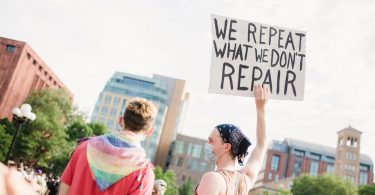Last weekend I left the noise and clamour of London and travelled to the quiet hills and rolling meadows of the Cotswolds. On my Saturday afternoon, I walked into a Baptist church in center of Chipping Campden and somehow the commotion of the city came tumbling back into my mind as I starred at an anti-human trafficking campaign poster: UNITED TO END SLAVERY.
In 2013 I worked at the anti-human trafficking NGO, based in the heart of Antwerp’s Red Light District. The organization I was working for, Payoke, is largely made up of social workers, and does wonderful work. It provides social and psychological care for survivors, as well as legal and administrative support that can often lead to Belgian citizenship. After years of disputes and corruption, Payoke now collaborates with the police, border control and the judicial system with relative ease. But in recent years there seems to have been a moral panic over human trafficking. Particularly since the passage of the UN Palermo Protocol, NGOs have been popping up like wildfire. There are so many that a directory had to be created on Wikipedia.
Are human trafficking numbers distorted?
But something suspicious occurs when you delve a little further into the information provided by these organizations. The first is the most obvious: numbers. Equality Now claims that there are 12.3 million adults and children bought and sold worldwide. Free the Slaves says that there are between 21 and 37 million, and Walk the Free have found that there are 35.8 million. Stone in shoe have chosen to quote Global Slavery Index, claiming there are 29.8 million. The discrepancy in these numbers is often left unquestioned. Throwing a couple of extra zeros at the end of this type of statistic is perhaps insignificant. You might say one victim is bad enough.. But if this is the case, why are we attempting to quantify a phenomenon that is essentially impossible to calculate?
Human Trafficking is labour exploitation. A victim is an individual who is coerced into working, against their will, for nothing or very little. It doesn’t matter what type of labour, or even whether they crossed a border. This is a pretty large, and somewhat legally flexible definition because it involves the deeply complex phenomenon of consent. We therefore have absolutely no idea how many people in the world work in these conditions. It’s probably impossible to find out. What might be regarded as exploitative in one country might be the norm in another. But more obviously, a state does not quantify how many people are working illegally against their will, since the state, does not know they exist. Yet, not only do we insist on calculating the numbers, apparently it is the growing fast, and headlines seem to adhere to the idea that it is “rising,” even though labour exploitation has always existed.
Curious methodology
The methodology used is sceptical at best. For example, Walk the Free developed questions “designed to elicit information on modern day slavery.” I’m dying to know what those questions are, which, it seems, were only limited it to seven countries. One of the reasons being that they wanted to “ensure regional representation.” I’d love to know what Ethiopia, Russia, Brazil and Nepal have in common.
The UK government has attempted to tackle human trafficking through various means, mostly through the police, border control and law enforcement. There was an Action Plan in 2007, and particularly attention was paid during the 2012 Olympics. Yet the number of victims found has been minute and few victims have been “saved.” In fact, in 2012 the police arrested suspected victims, and instead found themselves charging those same women for running a brothel.
Yet there continues to be a rise in the number of NGOs and campaigns attempting to “help.” This is problematic. We are prioritizing one type of migrant over another based on the State’s framework of consent and what is deemed lawful. Take someone who has smuggled themselves into a country vs. a victim of trafficking. The first might have taken dozens of cars, coaches trains and/or buses, walked miles, only to hide and work in exploited conditions. But because they defied the state’s borders, their stories are muted, and if the individual is found, he or she will be deported. Compare this to a victim of trafficking, who, since he or she is defined as a victim by law, has their stories spread across newspapers and websites alike. Yet even though consent is a complex phenomenon, and the stories between these two groups are often very similar, only one is worthy of attention. Lawyers might adhere to the distinction. But we, the public, should not.
By launching huge campaigns against “modern day slavery,” we are placing one type of exploited migrant above another, and the state becomes a saviour. This shadows our judgment, and makes us ignore the harder questions. Could it be that it is our own underlying economic or immigration policies and laws that might be influencing or causing the use of cheap labour in the first place?








